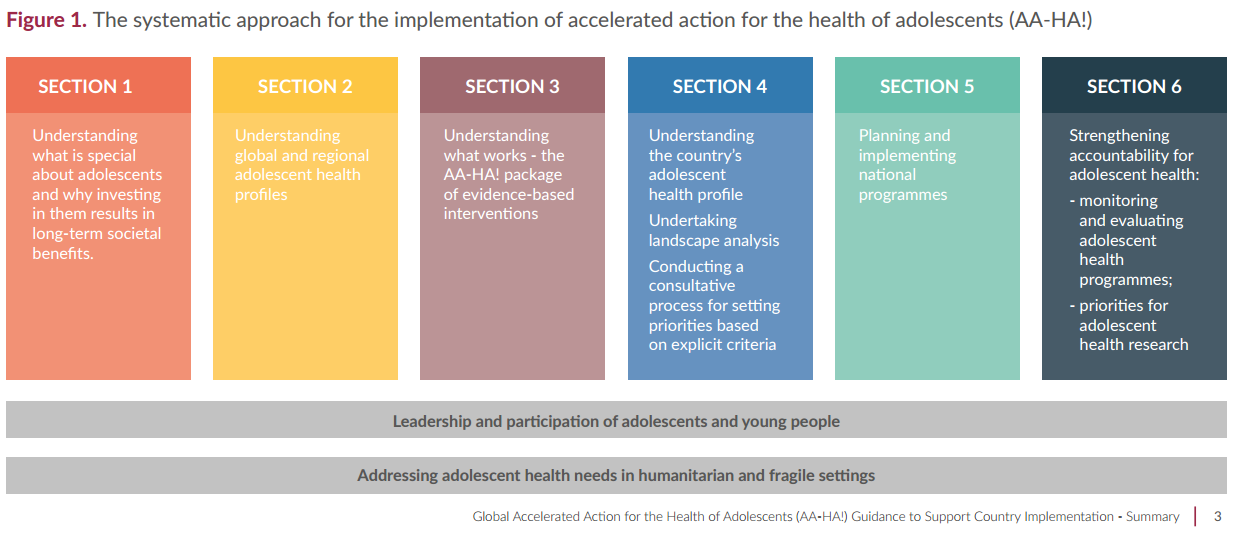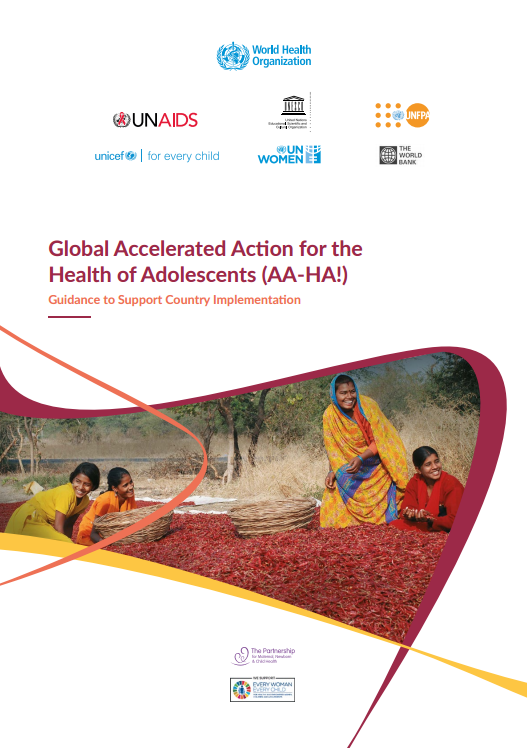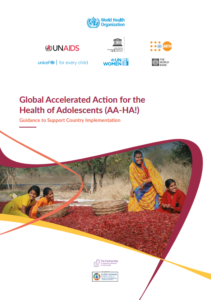On Tuesday 16 May, we were thrilled to see the launch of the Global Accelerated Action for the Health of Adolescents (AA-HA!). The launch event took place at the Global Adolescent Health Conference, Ottawa, Canada and was hosted by the Canadian Partnership for Women and Children’s Health (CanWaCH), along with Every Woman Every Child (EWEC), the Partnership for Maternal, Newborn and Child Health (PMNCH) and WHO.
 What is the Global AA-HA! Guidance?
What is the Global AA-HA! Guidance?
Simply put, the Global AA-HA! Guidance aims to assist governments in deciding what they plan to do – and how they plan to do it – as they respond to the health needs of adolescents in their countries.
It is intended as a reference document for national-level policy-makers and programme managers to assist them in planning, implementing, monitoring and evaluation of adolescent health programmes.
The Guidance summarises the main arguments for investing in adolescent health, and details the key steps from understanding the country’s epidemiological profile, undertaking a landscape analysis to clarify what is already been done and by whom, conducting a consultative process for setting priorities, to planning, implementing, monitoring and evaluating national adolescent health programmes. It also includes key research priorities and case studies to illustrate that what is being recommended can be done, and in some cases has already been done.
Global AA-HA! Guidance has 6 overarching messages
1. Approach
The AA-HA! guidance provides a systematic approach for understanding adolescent health needs, prioritising these in the country context and planning, monitoring and evaluating adolescent health programmes.
2. Prevention
More than 3000 adolescents die every day from largely preventable causes such as unintentional injuries; violence; sexual and reproductive health problems, including HIV; communicable diseases such as acute respiratory infections and diarrhoea; noncommunicable diseases, poor nutrition and lack of physical activity; and mental health, substance use and suicide. Even more suffer from ill health due to these causes. Although much research is still needed, effective interventions are available for countries to ACT NOW.
3. Priority setting
The nature, scale and impact of adolescent health needs vary between countries, between age groups and between the two sexes. Funds are limited, and governments should prioritise their actions according to the disease and injury risk factor profiles of their adolescent population, as well as the cost-effectiveness of the interventions. Adolescent health needs intensify in humanitarian and fragile settings.
4. Leadership
Strong leadership at the highest level of government should foster implementation of adolescent-responsive policies and programmes. To accelerate progress for adolescent health, countries should consider institutionalizing national adolescent health programmes. Through the Sustainable Development Goals and the Global Strategy for Women’s, Children’s and Adolescents’ Health (2016–2030), globally agreed targets related to adolescent health exist, along with indicators to monitor progress towards these. Age and sex disaggregation of data will be essential.
5. Yields from investing in adolescent health span across generations
There is a pressing need for increased investment in adolescent health programmes, to improve adolescent health and survival in the short term, for their future health as adults, and for the next generation. This is a matter of urgency if we want to curb the epidemic of noncommunicable diseases, to sustain and reap the health and social benefits from the recent impressive gains in child health, and ultimately to have THRIVING and peaceful societies.
6. Together
WITH adolescents, FOR adolescents. Adolescents have particular health needs related to their rapid physical, sexual, social and emotional development and to the specific roles that they play in societies. Treating them as old children or young adults does not work. National development policies, programmes and plans should be informed by adolescents’ particular health related needs, and the best way to achieve this is to develop and implement these programmes with adolescents.
Whole-of-government. To achieve the Sustainable Development Goal targets, the health and other sectors need to normalise attention to adolescents’ needs in all aspects of their work. An Adolescent Health in All Policies* (AHiAP) approach should be practised in policy formulation, implementation, monitoring and evaluation.
*AHiAP is an approach to public policies across sectors that systematically takes into account the implications of decisions for adolescent health, avoids harmful effects and seeks synergies – in order to improve adolescent health and health equity. It is a strategy that facilitates the formulation of adolescent-responsive public policies in all sectors, and not just within the health sector.
Adolescent participation
Countries should ensure that adolescents’ expectations and perspectives are included in national programming processes. Adolescent leadership and participation should be institutionalized and actively supported during the design, implementation, monitoring and evaluation of adolescent health programmes. Furthermore, respecting adolescents’ views regarding their health care ensures that more adolescents will seek services and remain engaged in accessing them.
From a developmental perspective, the engagement of adolescents enhances adolescent-adult relationships, develops adolescent leadership skills, motivation and self-esteem, and enables them to develop the competencies and the confidence they need to play an active, positive and pro-social role in society.
Resources
- Summary document – Provides a brief summary of the key content in the AA-HA! guidance
pdf, 3.3Mb - Main document including case studies
pdf, 5Mb - Annexes and appendices
pdf, 4.4Mb - Global AA-HA! Guidance brochure – A brochure created to facilitate dissemination
pdf, 3.2Mb - Akilah and Carlos’s big day of discovery – A comic book based on the key messages, written for young adolescents
pdf, 3.2Mb - Infographics on adolescent health issues

